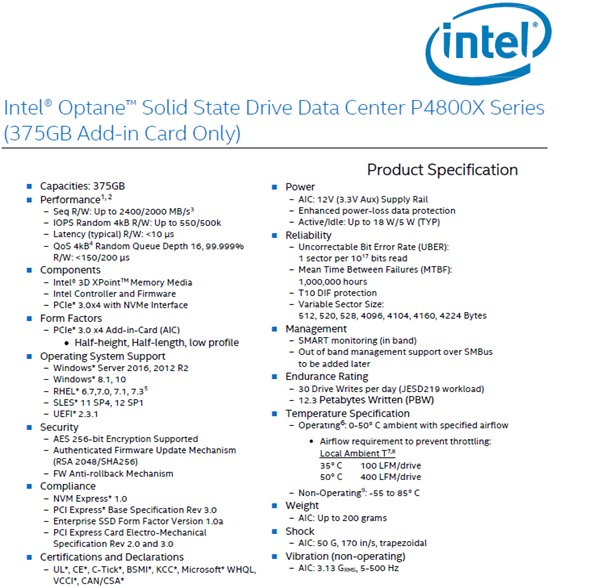Intel is readying a fleet of new SSDs based on its new 3D XPoint non-volatile memory, a technology that Intel hopes will replace NAND flash in the years to come. The company developed this technology in collaboration with Micron Technology, under its IMFlash Technologies banner. The first Intel SSDs with this memory will be sold under the Optane brand. There are several sub-brands targeting the various market segments (client, enterprise, data-center, etc.), and technical slides of the data-center targeted Optane DC P4800X SSD were leaked to the web.

One of the first Optane DC P4800X SSDs comes in a rather measly capacity of 375 GB. The drive is built in the half-height PCI-Express add-on card (AIC) form-factor, with PCI-Express 3.0 x4 host interface. The drive belts out sequential transfer rates of up to 2400 MB/s reads, with up to 2000 MB/s writes, which may not sound like much given that even TLC NAND flash based PCIe 3.0 x4 drives offer higher transfer rates; until you look at three key metrics - latency, random-access performance, and endurance.
According to the specs-sheet of the Optane DC P4800X 375 GB AIC SSD, the drive offers over 21 times the endurance of comparable enterprise SSDs based on high-endurance MLC NAND flash; with a staggering 30 drive-writes per day (DWPD); and 12.3 petabytes (12,300 TB) total bytes written (TBW) rating. This is extremely high for a drive with just 375 GB of user-space. The random-access performance of the drive is also higher than competing MLC NAND flash based drives, with up to 550,000 IOPS 4K random reads, and up to 500,000 IOPS 4K random writes. |